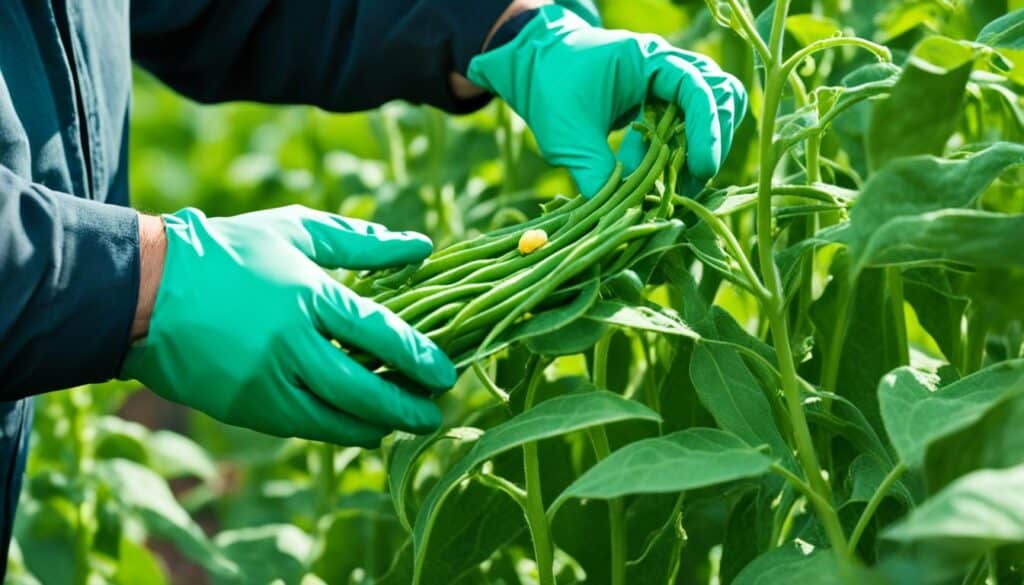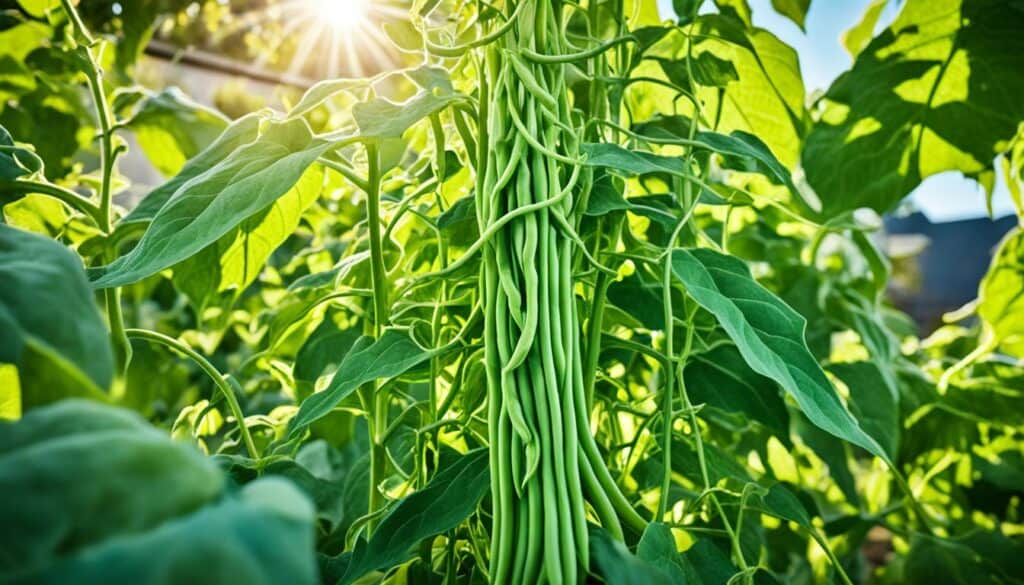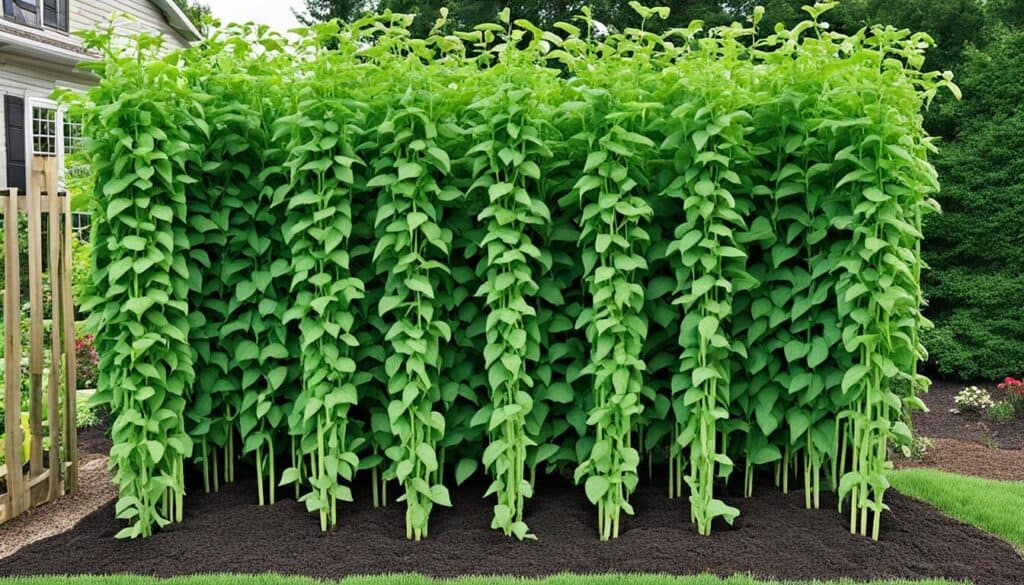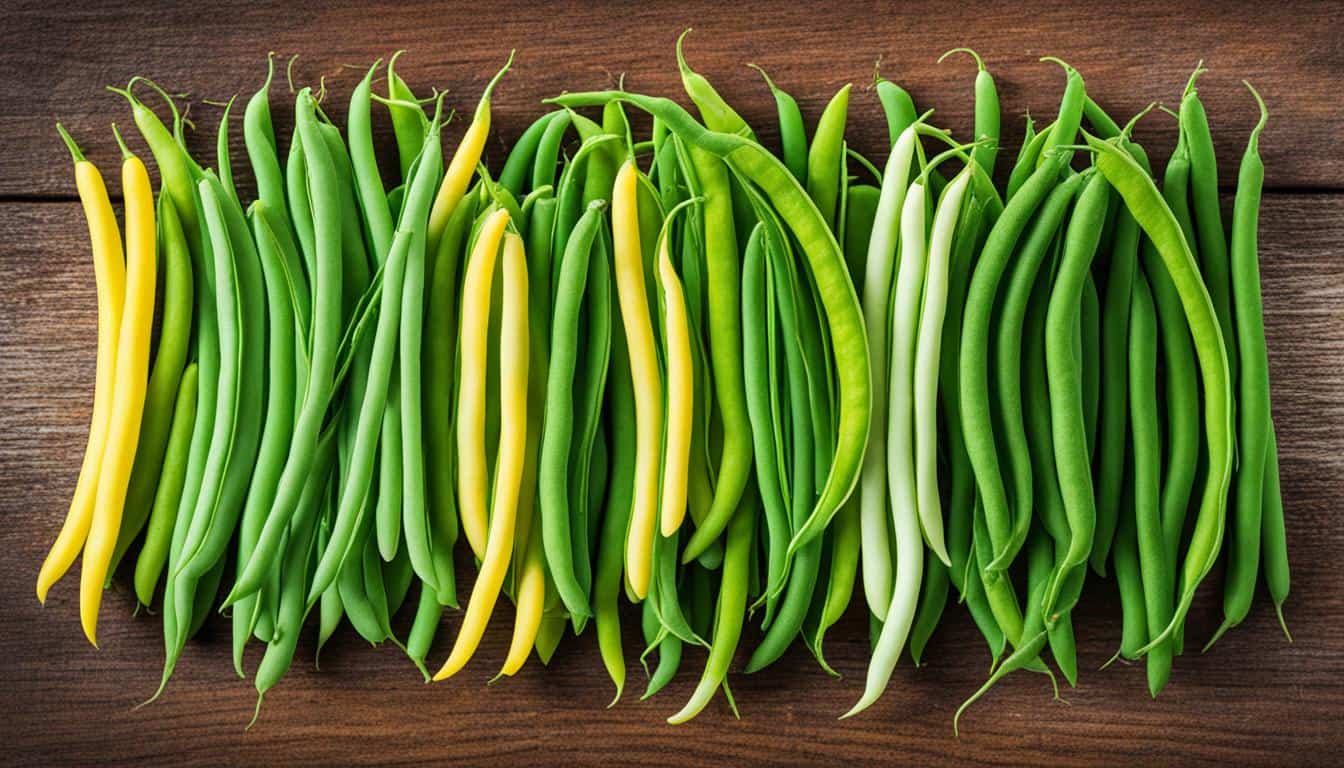Did you know that green beans are one of the easiest and most rewarding vegetables to grow in your garden? Whether you have acres of land or just a small container on your porch, you can enjoy a bountiful harvest of fresh and flavorful green beans. From their versatility in cooking to their high productivity, green beans are a favorite among home gardeners.
Key Takeaways:
- Growing green beans is a simple and rewarding gardening activity.
- Green beans can be grown in various spaces, from large gardens to small containers.
- There are different varieties of green beans to choose from, each offering unique flavors and colors.
- Proper care and maintenance, including watering and monitoring for pests and diseases, are key to successful green bean cultivation.
- Harvest green beans when they are tender and young for the best flavor.
When and Where to Plant Green Beans
Growing green beans is a rewarding experience that can yield a bountiful harvest of delicious and nutritious vegetables. To ensure the success of your green bean plants, it’s important to plant them at the right time and in the ideal conditions. Here are some tips to help you get started:
- Timing: Wait until the danger of frost has passed before planting green beans. Late spring is generally the best time to plant them.
- Sunlight: Green beans thrive in full sun, so choose a location in your garden that receives at least 6-8 hours of direct sunlight each day.
- Soil: Green beans prefer well-worked soil with a pH between 6.0 and 7.0. Make sure the soil is loose and fertile, as this will help the plants establish strong roots.
- Planting Method: There are two common methods for planting green beans: directly sowing seeds in the garden or starting them indoors and transplanting them outdoors. If you choose to start them indoors, make sure to wait until the soil temperature reaches around 70°F before moving the seedlings outside.
- Spacing: Green beans should be spaced 4-6 inches apart in rows to allow for proper air circulation and growth. If you’re planting bush beans, consider spreading out plantings every 10 days to stagger the harvest.
- Watering: After planting the green bean seeds, water them immediately to help them settle in the soil. Keep the soil consistently moist throughout the growing season, especially during hot and dry periods.
- Mulching: Adding a layer of organic mulch around the base of the plants can help conserve moisture and suppress weed growth. This will create ideal conditions for green beans to thrive.
“Green beans should be planted after the danger of frost has passed in late spring.”
By following these tips and providing the right planting conditions, you’ll be on your way to growing healthy and productive green beans in your own garden.
Varieties of Green Beans
Green beans come in a variety of cultivars, including bush beans and pole beans. These different varieties offer a range of colors, flavors, and textures, adding variety and excitement to your garden. When choosing green bean seeds, it’s important to consider factors such as taste, disease resistance, and growth habit.
Popular Green Bean Varieties
- Antigua
- Blue Lake Pole
- Borsalino
- Carminat
- Celine
- Dragon Tongue
- Kentucky Wonder
- Purple Queen Improved
- Velour
- Wyatt
These popular green bean varieties offer a diverse range of flavors and colors. For example, Dragon Tongue beans have yellow pods with purple streaks, while Kentucky Wonder beans are known for their excellent taste. Whether you prefer the classic green beans or want to try something more vibrant, there’s a variety to suit your taste.
When selecting green bean seeds, it’s also important to consider the growth habit. Bush beans grow in a compact manner and don’t require support, making them perfect for small gardens or containers. On the other hand, pole beans are climbers and will need a trellis or support structure to grow vertically. Choose the type that best suits your space and gardening preferences.
Here’s a visually engaging table highlighting the popular green bean varieties and their key characteristics:
| Variety | Color | Flavor | Growth Habit |
|---|---|---|---|
| Antigua | Green | Earthy | Bush |
| Blue Lake Pole | Green | Classic | Pole |
| Borsalino | Yellow | Buttery | Bush |
| Carminat | Purple | Mild | Bush |
| Celine | Green | Crunchy | Pole |
| Dragon Tongue | Yellow with Purple Streaks | Sweet | Pole |
| Kentucky Wonder | Green | Savory | Pole |
| Purple Queen Improved | Purple | Tender | Bush |
| Velour | Green | Rich | Pole |
| Wyatt | Yellow | Delicate | Pole |
As you can see, there are plenty of options to choose from when it comes to green bean varieties. Consider your preferences and growing conditions to select the best green bean cultivars for your garden.
Watering and Fertilizing Green Beans
Proper watering and fertilization are crucial for the healthy growth and productivity of green beans. In this section, I will share valuable tips on watering green beans, maintaining soil moisture, and providing essential nutrients to ensure your green bean plants thrive.
Careful Watering for Optimal Growth
Green beans require consistent moisture to flourish, especially during hot weather. It is recommended to water them regularly, providing approximately 1 inch of water per week. During dry spells, additional watering may be necessary to maintain soil moisture levels.
Tip: Water at the base of the plants to prevent wetting the foliage, as this can lead to the development of diseases.
To retain moisture in the soil and reduce evaporation, consider adding a layer of organic mulch around the plants. Mulching also helps to regulate soil temperature and suppress weed growth, providing an ideal environment for your green beans to thrive.
Fertilizing for Nutrient-Rich Soil
As legumes, green beans have a symbiotic relationship with nitrogen-fixing bacteria. This means they can obtain nitrogen from the air and convert it into a form that is easily accessible for their growth. As a result, green beans do not require heavy fertilization.
However, incorporating compost into the soil before planting can provide additional nutrients for optimal growth. Compost enriches the soil with organic matter, improving its texture and fertility.
Tip: Prior to planting, mix well-rotted compost into the soil, ensuring it is evenly distributed. This will ensure your green bean plants have access to the nutrients they need throughout their growth cycle.
Fertilizer application during the growing season should be minimal, as over-fertilization can lead to excessive foliage growth at the expense of bean production. Instead, focus on maintaining soil health through regular additions of compost and proper watering.
By following these watering and fertilizing tips, you can provide the ideal growing conditions for your green bean plants. Consistent moisture and nutrient-rich soil will promote vigorous growth and maximize your green bean harvest.
Common Pests and Diseases of Green Beans

As you cultivate your green bean plants, it’s essential to be aware of common pests and diseases that can affect their health and productivity. By recognizing and addressing these issues early on, you can protect your green beans and ensure a successful harvest.
Pests
There are several pests that commonly infest green beans, including Mexican bean beetles, aphids, thrips, and leafhoppers. These pesky critters can damage the leaves, stems, and bean pods, leading to stunted growth and reduced yields.
To control these pests and prevent their infestation, there are a few effective methods you can employ:
- Physical removal: Inspect your plants regularly and manually remove any pests you find. This method works well for larger pests like Mexican bean beetles. Simply pluck them off the plants and dispose of them away from your garden.
- Organic sprays: Utilize natural pest control sprays made from ingredients like neem oil or insecticidal soap. These sprays are safe for your plants and the environment while effectively deterring and killing pests.
- Row covers: Covering your green bean plants with lightweight fabric row covers can provide a physical barrier against pests. The covers allow air, light, and water to pass through while preventing insects from reaching the plants.
Diseases
Green beans can also fall victim to various diseases, such as bean common mosaic virus and bean rust. These diseases can weaken the plants, cause discoloration, and reduce overall vigor.
To prevent the spread of diseases and maintain the health of your green bean plants, consider the following practices:
- Proper sanitation: Keep your garden clean and free from debris that can harbor disease-causing pathogens. Remove and dispose of any infected plant material, as this can help prevent the spread of diseases to healthy plants.
- Avoid overhead watering: Wet foliage can create an ideal environment for disease development. Instead, water at the base of the plants, directing the water towards the soil and away from the leaves.
- Remove infected plants: If you notice signs of disease, such as yellowing, spots, or lesions, promptly remove the affected plants from your garden. This action can prevent the disease from spreading to nearby plants.
Closely monitoring your green bean plants for signs of pests or diseases is crucial. Regular inspection allows you to detect any issues early and take immediate action to mitigate their impact.
Common Pests and Diseases of Green Beans – Quick Reference Table
| Pest or Disease | Description | Control Methods |
|---|---|---|
| Mexican bean beetles | Small, oval-shaped beetles that feed on green bean foliage | Physical removal Organic sprays Row covers |
| Aphids | Tiny insects that suck sap from the plant, causing deformities and discoloration | Physical removal Organic sprays |
| Thrips | Minute insects that feed on leaves and buds, causing silvering and distortion | Physical removal Organic sprays |
| Leafhoppers | Small, wedge-shaped insects that feed on plant sap, leading to stunted growth | Physical removal Organic sprays |
| Bean common mosaic virus | A viral infection that causes stunted growth, mottled leaves, and deformed pods | Remove infected plants Control aphid populations |
| Bean rust | Fungal disease characterized by rust-colored spots on foliage and pods | Remove infected plants Improve air circulation |
Harvesting Green Beans
When it comes to harvesting green beans, timing is everything. For the best flavor and texture, it’s important to pick the beans when they are tender and before they become tough and stringy. Most green bean varieties are ready to harvest when the pods reach a length of 4-6 inches.
To maximize your green bean yield, it’s recommended to harvest the beans every few days. Regular harvesting not only encourages the plant to continue producing more beans but also helps prevent pods from becoming overripe. Overly mature pods should be promptly removed to ensure the plant’s energy is focused on pod development rather than seed production.
Preserving your excess green beans is a great way to enjoy them throughout the year. There are several methods for preserving green beans, including pickling, blanching, and freezing. Each method has its own benefits and flavor profiles, so you can choose the preservation technique that best suits your preferences.
For pickling green beans, you can use a simple brine solution and add flavorings such as garlic, dill, or spices to create delicious pickled green beans. Blanching involves briefly boiling the beans and then cooling them in ice water before freezing. This process helps retain the beans’ vibrant color and crispness. Freezing is a convenient method that allows you to enjoy green beans in various cooked dishes throughout the year.
By harvesting green beans at the right time and preserving the excess, you can savor the delicious flavors of your garden all year round.
Growing Green Beans: Tips for Success

To ensure successful green bean cultivation, it is crucial to provide the right growing conditions. Here are some essential tips and best practices:
1. Plant in Well-Drained Soil
Green beans thrive in well-drained soil with a pH level between 6.0 and 7.0. Ensure the soil is loose and rich in organic matter to promote healthy root development.
2. Provide Full Sun Exposure
Green beans require at least six to eight hours of direct sunlight daily. Choose a sunny spot in your garden to maximize their growth and yield.
3. Water Consistently
Maintain consistent soil moisture by watering your green bean plants regularly. Aim to provide around one inch of water per week. Avoid overwatering to prevent waterlogging.
4. Proper Spacing
When planting green beans, ensure proper spacing between plants and rows. This allows for efficient growth and makes harvesting easier. Bush beans should be spaced 4-6 inches apart, while pole beans require 6-8 inches between plants.
5. Monitor for Pests and Diseases
Regularly inspect your green bean plants for signs of pests and diseases. Common pests include aphids, bean beetles, and leafhoppers. Look out for diseases like bean common mosaic virus and bean rust. Take immediate action at the first signs of infestation to prevent damage and promote healthy plant growth.
6. Succession Planting
To maximize your green bean yield, consider succession planting. This involves sowing new seeds every few weeks to ensure a continuous harvest throughout the growing season. By staggering the planting, you can enjoy a prolonged supply of fresh green beans.
7. Harvest at the Right Time
Harvest green beans when the pods are tender and crisp. Pick them regularly, every few days, to encourage continuous production. Promptly remove overripe or mature pods to redirect the plant’s energy towards developing new pods.
8. Preserve and Enjoy
If you have an abundant green bean harvest, consider preserving the excess beans. Pickling, blanching, or freezing are great ways to extend the shelf life and enjoy the harvest throughout the year.
By following these tips and best practices, you can maximize your green bean yield and enjoy a bountiful harvest of delicious homegrown beans. Happy gardening!
Types of Green Beans to Grow

When it comes to choosing the right type of green beans to grow, you have two main options: bush beans and pole beans. Let’s explore the characteristics of each type to help you make an informed decision.
Bush Beans:
Bush beans are compact plants that grow in a bush-like shape without requiring any support. They are perfect for small gardens or containers, making them an excellent choice for urban gardeners or those with limited space. Bush beans are also easy to harvest since their compact size keeps the beans close to the ground.
Pole Beans:
Pole beans are climbers and will need a trellis, fence, or other support structure to grow. They produce long vines that can reach impressive heights, allowing you to maximize your vertical garden space. In addition to their height advantage, pole beans often have a longer harvest period compared to bush beans, providing you with a continuous supply of fresh beans throughout the season.
Both bush beans and pole beans offer a wide range of delicious varieties to choose from. Whether you prefer the ease and compactness of bush beans or the vertical growth and extended harvest of pole beans, there is a green bean variety to suit your personal taste, desired texture, and preferred appearance.
Now that you are familiar with the two main types of green beans, you can select the variety that best fits your gardening needs and preferences. Happy growing!
Tips for Growing Green Beans in Containers
Green beans can be successfully grown in containers, making them a great option for those with limited garden space. Whether you have a small balcony or a tiny backyard, container gardening allows you to enjoy the benefits of growing your own fresh green beans.
When it comes to container gardening, choosing the right containers for your green beans is crucial for their growth and productivity. Here are some container gardening tips to help you grow healthy and abundant green beans in pots:
- Container size: For bush beans, choose a container that is at least 15 inches in diameter. If you prefer pole beans, go for a larger container, ideally 18 inches in diameter. Smaller containers can restrict root growth and affect the plant’s overall health and yield.
- Potting mix: Use a high-quality potting mix specifically formulated for container gardening. Mix in some compost to enrich the soil and provide essential nutrients for the green beans.
- Sunlight: Place your containers in a sunny location where the green beans can receive at least 6-8 hours of direct sunlight each day. Green beans thrive in full sun, so choose a spot that gets maximum exposure.
- Watering: Regular watering is crucial for container-grown green beans. Check the soil moisture regularly and water when the top inch of soil feels dry. Ensure proper drainage to prevent waterlogging, which can lead to root rot.
- Support: If you’re growing pole beans, provide support for the plants to climb. Use a trellis, stake, or a sturdy cage to help the vines reach their full potential.
By following these container gardening tips, you can create a thriving environment for your green beans and enjoy a bountiful harvest, even in a limited space.
Benefits of Container Gardening for Green Beans
Container gardening offers several advantages when it comes to growing green beans:
- Flexibility: Containers allow you to grow green beans in any sunny spot, regardless of the size or layout of your outdoor space.
- Portability: If you’re renting or don’t have a permanent garden area, container gardening allows you to easily move your green beans wherever you go.
- Pest control: Container gardening can help minimize pest infestations, as it provides a barrier between your green beans and the ground, where many pests reside.
- Accessibility: With container gardening, you can elevate the plants to a comfortable height, reducing the strain on your back and knees when planting, maintaining, and harvesting your green beans.
So, whether you’re a beginner or an experienced gardener, container gardening can be a convenient and rewarding way to grow your own fresh green beans. Start your container garden today and enjoy a delicious harvest of homegrown green beans!
Best Green Beans to Grow
When it comes to growing green beans, choosing the right variety can make all the difference. Fortunately, there are several top-rated green bean varieties that consistently deliver exceptional flavor and productivity. Here are some of the best green beans to consider for your garden:
- Mascotte: This compact bush bean variety is perfect for small gardens or containers. It produces an abundance of tender, stringless beans with a delicious flavor.
- Provider: Known for its early maturity and high yields, Provider is a reliable choice for green bean enthusiasts. The beans are crisp and flavorful, making them a popular favorite.
- Contender: If you’re looking for disease-resistant green beans, Contender is an excellent option. This bush bean variety produces tender, stringless pods that are easy to harvest.
- Emerite: With its elegant, slender pods and exceptional taste, Emerite is a gourmet choice for green bean lovers. This French pole bean variety thrives when provided with proper support.
- Fortex: As a pole bean, Fortex offers extra-long pods that can reach up to 11 inches in length. Their tender texture and rich flavor make them a favorite for both fresh eating and cooking.
- Scarlet Runner: This unique pole bean variety not only produces edible pods but also vibrant red flowers. The beans have a rich, nutty flavor and can be used fresh or dried.
- Kew Blue: If you’re looking to add some color to your garden, Kew Blue is an excellent choice. These purple-podded bush beans are not only visually stunning but also have a delicate, sweet taste.
Experimenting with different green bean varieties can add variety and excitement to your garden. Whether you prefer bush beans or pole beans, there is a perfect green bean cultivar waiting for you to discover and enjoy.
Conclusion
Growing green beans can be a rewarding experience for gardeners of all skill levels. By following the tips and best practices outlined in this article, you can successfully grow green beans in your own garden. Whether you choose bush beans or pole beans, it’s important to provide proper planting conditions, consistent watering, regular monitoring for pests and diseases, and harvest at the right time.
To start off, consider the best time to plant green beans in your area, ensuring they have full sun exposure and well-worked soil with the right pH level. Remember to stagger plantings for bush beans to maximize the harvest. Proper spacing is vital for efficient growth, and adding organic mulch will help retain moisture in the soil.
While green beans generally require moderate watering, it’s important to water consistently, especially during hot weather. Avoid wetting the foliage, as it can lead to disease. Additionally, incorporating compost into the soil before planting will provide the necessary nutrients for healthy growth.
Lastly, be diligent in monitoring for common pests and diseases, taking immediate action at the first sign of infestation. Regular harvesting of the tender pods will encourage continuous production, and excess beans can be preserved through various methods.
By following these tips and techniques, you’ll be well on your way to enjoying a bountiful harvest of delicious green beans. Happy gardening!





Leave a Reply